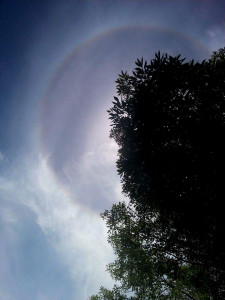ST. GEORGE – With recent storms moving through Southern Utah on a weekly basis, conditions have been good for seeing two fascinating sights in the sky: sun halos and sundogs.

| Photo courtesy of Janna Fox, St. George News
St. George resident Janna Fox was lucky enough to spot a sun halo Sunday, from her driveway at around 900 South and River Road.
“My 13-year-old son saw it first and came in and told us,” Fox told St. George News. “I had never seen a sun halo before, in my 35 years! It was neat!”
Both sun halos and sundogs are caused by sunlight passing through ice crystals in the high, thin cirrus clouds that often move in before a storm system. Sunlight reflects and bends, or refracts, causing these sometimes spectacular sights.
These ice-crystal displays can be seen year-round, because the upper atmosphere always below a freezing temperature.
A ring or circle of light around the sun or moon is called a halo, or, for the more scientifically minded, a parhelic circle or ring.
Sundogs are rainbow-colored splashes often seen to the left or right of the sun. Sundogs are also known as parhelions, and are formed by plate-shaped ice crystals drifting in the clouds, according to NASA.com.
Cirrus clouds are made of millions of hexagonal ice crystals 3 miles to 6 miles up in the atmosphere. Each ice crystal acts as a tiny prism bending the sun’s light and throwing it elsewhere into the sky. The spectacular displays in the sky depend on the size and tilt of the ice crystals.
There’s an old weather saying, “ring around the moon means rain soon,” and there is truth to that, according to Earthsky.org. High thin cirrus clouds often precede a storm system, at 20,000 feet. These clouds contain ice crystals, by the millions. The halos are caused by both refraction and reflection of sunlight.
Sundogs and sun halos are just two of nearly four dozen different kinds of effects produced by sunlight interacting with ice crystals in the sky.
So when’s the best way to catch one of these beauties in the sky? Both sun halos and sundogs may be seen whenever and wherever there are cirrus clouds in the sky.
The best displays are most commonly seen in the fall, winter and spring when the northern jet stream descends southward, drawing down Arctic air masses that carry ice crystals.
Sundogs are found at or more than 22 degrees to the left or right of the sun and at the same height above the horizon as the sun.
Because sundogs and sun halos are found near the sun, viewers should protect their eyes while viewing.
Read more: Solar viewing glasses; dates with the sun eclipse your vision
Resources
- NASA Web page Rings Around the Sun
- Earthsky.org Web page: What Makes a Halo
- ScienceFriday.com Picture of the Week: Sun Halo, With Sundog Companions
Related posts
- Zion park ranger shows night sky connection to past, future; star gazing event
- Ivins star party, public invited to view night sky through telescopes
- Explore: Mystic Hot Springs
- Zion park ranger shows night sky connection to past, future; star gazing event
- Get up early or stay up late, total lunar eclipse; STGNews Videocast
Email: [email protected]
Twitter: @STGnews
Copyright St. George News, SaintGeorgeUtah.com LLC, 2015, all rights reserved.
Julie, I love the nature articles you write.